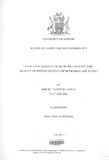| dc.contributor.author | Mburu, David N | |
| dc.date.accessioned | 2013-03-14T12:00:53Z | |
| dc.date.issued | 2011 | |
| dc.identifier.citation | Master of Science in Information Science | en |
| dc.identifier.uri | http://erepository.uonbi.ac.ke:8080/xmlui/handle/123456789/13853 | |
| dc.description.abstract | Telecommunication has evolved from the early days where information was conveyed using smoke
signs and drum beating through fixed wire communication to today's modem mobile wireless cellular
communication systems. In a Public Land Mobile Network, coverage is achieved through application
of the cellular concept and the principle of frequency reuse. The overall region is subdivided into small
units of area called cells which are covered with radio waves radiated from Base Stations and which
provide connection of the Mobile Stations to the Network. As the mobile Subscriber traverses the
network, there is need to have the resources that maintain and manage the connection transparently
transferred between neighbouring cells. This process is referred to as Handoff and requires to be
catered for in planning of the network through implementation of an efficient Handoff Scheme. The
effects of Handoff is determined through the PCB and PHD, and their cumulative resultant the GoS.
The methods encountered in literature highlight theoretical methods of determining Network GoS.
Most of these methods start by modeling hypothetical networks for analysis where factors that
influence the quantities (PCB and PHD) to be determined like cell shape, capacity, MS speed are
approximated. As a result of the inefficiency of these existing methods for determining QoS, a case
study was conducted to determine the QoS offered by the Kenyan GSM mobile Operators.
Two sets of data were collected from the leading three GSM operators. In the first set of data it was
deduced that the three Telecommunication Operators have implemented the non priority Handoff
scheme.
The numerical data obtained carried details of the recorded numbers of request to setup calls and to
handoff calls to the neighboring cells. This data was analyzed using simple statistics and probability
methods. The results revealed that Telecommunication Operator One offered a GoS of 41% during
busy Hour. This indicated a lot of congestion in the network. Due to this extremely high GoS another
set of data was acquired from the same Operator covering the non BH. On analysis of non busy hour
data it gave a GoS of 1.7% which is within the recommended limits. The deterioration of QoS during
busy hour has been attributed to the big number of Customers being served using equal resources to TO
with less than a fifth of the customers. Analysis of the other data from Telecommunication Operator
Two and Three revealed that the networks did not suffer from the problem of overload. The good QoS
found with TO two and Three was due to their small customer bases.
A solution to the problem of congestion was conceptualized in the form of Advanced Adaptive MultiRate
(AAMR) Codec and its suitability assessed. It was established that if deployed it is capable of
reducing congestion in TO Ones Network from 41% to 2%. This solution does not call for major
modification of the network and as demonstrated manages to reduce congestion during BH by a factor
of more than twenty.
Further research is recommended in the field of capacity expansion with minimal network changes.
Such network improvement can be achieved through exploration of the possible increase of the number
oftimeslots per the 200Khz frequency channel and revision of the modulation schemes employed. | en |
| dc.description.sponsorship | University of Nairobi | en |
| dc.language.iso | en | en |
| dc.publisher | University of Nairobi | en |
| dc.subject | Handoff | en |
| dc.subject | Network capacity | en |
| dc.subject | Quality of service | en |
| dc.subject | Kenya | en |
| dc.subject | GSM | en |
| dc.subject | Networks | en |
| dc.subject | case study | en |
| dc.title | Effects of handoff on network capacity and quality of service: Kenya GSM networks case study. | en |
| dc.type | Thesis | en |
| local.publisher | School of Computing and Informatics | en |

